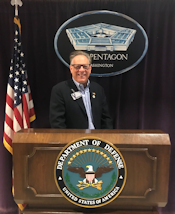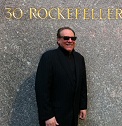NanoBusiness Interview – Dr. Alan Rae, CEO, NanoMaterials Innovation Center
Posted on November 21st, 2012 | No Comments »
In this month’s interview, we talk with Dr. Alan Rae, Chief Executive Officer of the NanoMaterials Innovation Center in Alfred, NY and Executive Director of Alfred Technology Resources Inc., operating business accelerators in Alfred, NY and Painted Post, NY.
I have known Dr. Alan Rae for over 10 years. He is one of the most fascinating scientists I have met in my career.
Dr. Rae has worked in the electronics, ceramics, nanotechnology and “clean tech” industries for over 25 years in the UK and USA, managing global businesses and technology development at start-up, operating company and corporate levels.
Dr. Rae is active in industry associations and standards work with the NanoBusiness Commercialization Association, iNEMI, ISO, SMTA, IMAPS, IPC, and JISSO. He has held Director and VP positions with 4 new companies and has consulted for two Fortune 100 companies in alternative energy. He is an Entrepreneur in Residence with NYSERDA and a member of the NYSERDA-UB Directed Assistance Committee for Directed Energy. He is a member of the National Academies Triennial Review Committee for the National Nanotechnology Initiative.
In our interview, we discuss Dr. Rae’s activities at the NanoMaterials Innovation Center, his work with the NNI and iNEMI, and the outlook for solar technology. We hope you enjoy the interview.
– Steve Waite, Director of Research and Strategy
SW: It is a pleasure to speak with you today, Alan. We thank you for taking time out of your busy schedule to talk to us. Give us a little background on the NanoMaterials Innovation Center (NMIC).
AR: Stepping back a little, in the 1990’s the Ceramic Corridor Innovation Centers were set up by Alfred Technology Resources Inc. (ATRI), a not-for-profit founded by Alfred University, Clarkson University and Corning Inc. as incubators for advanced materials. These business accelerators have been highly successful, running at or near 100% occupancy and returning $900M on New York State’s initial $10M investment. Three years ago ATRI identified that researchers were having difficulty scaling nanomaterials and other advanced materials from bench-top to the intermediate scale and set up a unique user facility, The NanoMaterials Innovation Center (NMIC), in Alfred, NY.
The NMIC facility contains many of the tools needed for advanced powder synthesis (plasma, sonochemical, combustion synthesis, carbon nanotube synthesis), fabrication (freeze drying, spray drying, dry pressing, isostatic pressing, tape casting, printing, lamination, dicing) and thermal processing (microwave; active and passive, single mode and multimode, air, vacuum and controlled atmosphere, batch and continuous). Products processed range from metal alloys to LED materials, fuel cell materials and a range of taggant phosphors. NMIC works in very close partnership with Alfred University which has many complementary skills and equipment. Clients have included major corporations as well as many start-up companies. NMIC does both contract processing and research programs, has submitted proposals jointly with Alfred, Buffalo, Cornell and Clarkson Universities and is working closely with The NSF Center for High-Rate Nanomanufacturing in New England.
SW: Tell us more about the Rare Earth initiative at the NMIC.
AR: Through our relationship with iNEMI we became aware of the importance of rare earths in electronics and renewable energy and were already talking to the supply chain members when one of our tenants approached us with a new technology they had developed to extract rare earths easily and economically from industrial wastes. We found this process also worked on pre and post-consumer electronic wastes and are founding a company called “ReNew” – which stands for Rare Earths, Not Electronic Waste, which has received initial funding and is raising additional capital to set up operations in a site we have identified in Steuben County near Corning, NY. We are being encouraged by the support of a major electronics recycler, a disk drive manufacturer, a ceramic capacitor maker and a Fortune 500 manufacturer of enterprise systems.
SW: That sounds interesting. Tell us more about the nano cement technology you are developing and how it is coming along.
AR: At NanoDynamics, we developed a cement additive that could double the strength of Portland cement and could reduce its setting time from 28 to 5 days. At TPF Enterprises, working closely with Purdue University, InVentures Group and the Army Corps of Engineers, we scaled production of a number of processes to achieve this type of additive to tonnage levels. TPF is now a subsidiary of ATRI. We are working closely with InVentures Group to commercialize some of these under the “AdvanCement” name. As with ReNew, AdvanCement has received initial funding and is raising additional capital to set up operations in a site we have identified in Steuben County near Corning, NY.
SW: How do you see the NMIC evolving in the years ahead under your leadership?
AR: We’re working to get the word out about this facility nationally as well as locally and as a first step we have engaged Creyr Innovation to enhance our service to New England clients. As technologies evolve we plan to expand the facilities to provide a more complete service and to develop spin-offs from our research programs which will help fund NMIC and ATRI’s growth and continue to stimulate economic activity in the Southern Tier of New York State.
SW: Sounds good. We understand you have been working with the NNI recently. Please tell us tell us about your involvement with the NNI.
AR: I am privileged to be a member of the Triennial Review of NNI by the National Academies. I cannot talk about the conclusions as the final report is not published, but the Interim Report is available on the National Academies web site (http://www.nap.edu/catalog.php?record_id=13517). From a personal point of view this has been a great opportunity to work with some very smart people and a very professional organization meeting representatives of the NNI and its 26 member agencies and reviewing this significant initiative. Did you know that President Lincoln formed the National Academy of Sciences in 1863 to “investigate, examine, experiment, and report upon any subject of science”?
SW: No, we did not know that. Very interesting! You have been involved with iNEMI for the past decade. What is your role with iNEMI and when is the new roadmap for the consumer electronics segment due out?
AR: Every two years iNEMI (www.iNEMI.org) produces a Technology Roadmap that explores technology needs for the electronics industry based on technology emulators not just for consumer electronics but for enterprise systems, automotive and other sectors. This roadmap identifies key technology and market development trends and drills down to a high level of detail. iNEMI coordinates with ITRS (semiconductors) and IPC (board assembly) so that the three roadmaps are consistent. The Research Committee, where I am co-chair, works with the chapter chairs and the Technical committee to identify the longer-term “gaps and showstoppers” that may impede progress. The committee reviews these and presents them in a format that can be used to encourage corporate research, government laboratories and university research. As the roadmap completes over the next month, the Research Committee starts its work. A summary of the previous roadmap’s Research Priorities is available at http://thor.inemi.org/webdownload/Pres/EGG2012/Research.pdf.
SW: What types of nano-enabled electronics applications are we likely to see in the near future?
AR: Apart from semiconductors, which have been in the nano domain for many years, we see a number of nano and near-nano products already on the market including oleophobic stencil coatings (LaserJob), corrosion-resistant board surfaces (Semblant), water-repellant coatings for consumer electronics and solar cell materials (HzO, C-Voltaics) as well as conductive and interconnect systems (iimak, Novacentrix, Cookson Electronics).
SW: What other nano-enabled electronics applications should we be on the lookout for in the years ahead?
AR: Check out the Center for High Rate Nanomanufacturing www.nano.neu.edu/ to see a glimpse into the future of printed electronics through electrophoresis, templating, imprint and other practical processes. We will be able to integrate sensors and processing into flexible circuits through roll to roll processing at last!
SW: You have been working with photo-voltaic technology over the past five years. What are we seeing today and what’s the outlook for solar, and specifically, nano-enabled solar technology?
AR: Once solar gets past the current train wreck – oversupply, uncertainty on subsidies, anti-dumping action, bankrupt and zombie companies worldwide with 180 of 300 recently predicted to fail by GTM – the move towards renewable energies will continue. Nano and thin film solar are currently suffering due to the high overcapacity and low price of competing silicon cells but eventually they will win out as they are more materials-efficient. Less materials means lower cost when volumes are comparable. Consolidation is a normal part of industry development – we’ve see it in every major industry from semiconductors to automobiles to beer!
In the U.S., we have an energy breathing space due to the new-found abundance of low-cost natural gas that can be used for lower-carbon fuel for heating, electricity generation and transportation. Ironically gas is also needed to balance renewable fluctuations – when the sun doesn’t shine and the wind doesn’t blow – and only gas generators can crank up output at short notice. Another interesting fact is that recent statistics show that even in the U.S., renewables are not a niche but are a significant contributor to the jobs market and to power generation – the most recent federal statistics show solar at 0.3%, wind at 4.4% and hydro at 8.5%. All have room for expansion – but in order to develop a sustainable industry we have to stop renewable energy being a political pawn with short term boom and bust economics worldwide. Sometimes it’s good to be a high-profile industry but sometimes it isn’t!
SW: Thanks again for your time, Alan. It was a pleasure speaking with you. We wish you all the best in the future.
I would like to wish you and your family a wonderful Thanksgiving holiday.
Regards,
Vincent Caprio “Serving the Nanotechnology Community for Over a Decade”
Executive Director
NanoBusiness Commercialization Association
203-733-1949
vincent@nanobca.org
www.nanobca.org
www.vincentcaprio.org




